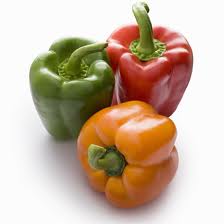|
- Bell pepper contains an impressive list of plant nutrients that are known to have disease preventing and health promoting properties. Unlike other chili peppers it is very low in calories and fats.
- It also contains good levels of vitamin-A.
- Bell pepper has adequate levels of essential minerals. Some of the main minerals in it are iron, copper, zinc, potassium, manganese, magnesium and selenium.
- Further, capsicum (sweet pepper) is also good in B-complex group of vitamins such as niacin, pyridoxine (vitamin B-6), riboflavin and thiamin.
|
- Fresh raw bell peppers are being used as vegetables in cuisines. They can be eaten as salads or cooked in stir-fries.
- In many parts of the South Asia, they are mixed with other vegetables like potato (aloo-simla mirch), carrots, aubergine, green beans etc. along with tomato, garlic, onion, mustard seeds, cumin and other spices in various mouth-watering stir-fries.
- They can also be stuffed with rice, meat, cheddar cheese, dried fruits, nuts, etc. and then cooked.
- They can also be grilled and served with sauce, cheese and olive oil or with dips.
- Finely chopped peppers can be used in Chinese-style vegetable stir-fries and noodles.
- Peppers are one of the popular ingredients in Italian pizza and pasta.
|

